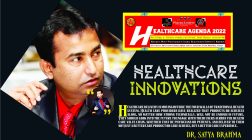Care Hospital Chief & Noted Cardiologist Dr. Somaraju Bhupathiraju to receive the prestigious “India’s Most Admired Surgeon 2014” at Indian Affairs 5th Annual India Leadership Conclave 2014
Care Hospital Chief & Noted Cardiologist Dr. Somaraju Bhupathiraju to receive the prestigious “India’s Most Admired Surgeon 2014” at Indian Affairs 5th Annual India Leadership Conclave 2014
Noted Cardiologist & the architect of Care Hospitals Dr. Somaraju Bhupathiraju has been selected by the juries of the Network 7 Media Group to receive the coveted India’s Most Admired Surgeon 2014 at the historic 5th Annual India Leadership Conclave & Indian Affairs Business Leadership Awards 2014 ( www.ilc2014.in ). In a statement released to media from the Network 7 Media Group(www.network7mediagroup.in )
Care Hospitals draws its life-blood from the eminent personalities like Padmashri. Dr. B. Somaraju who has spearheaded this movement called ‘CARE’. Prof. B. Soma Raju, Cardiologist from Hyderabad has been providing dedicated service to the people for over 30 years as Cardiologist, Researcher, Teacher and Philanthropist.
He has been involved in various research projects during the last 20 years individually, in collaboration with American Universities and the Defense Scientific Laboratories. The last association culminated in the development of India’s first Coronary Stent, which has been named the Kalam Raju Stent after Professor A.P.J Kalam and Dr. Raju. This stent was first implanted in December 1996. The development of the stent resulted in reducing the cost of stents in the country and brought it within the reach of the people. In October 1998 the second research product of Dr. Raju’s endeavor, India’s first Coronary Balloon Catheter was released. Dr. Raju and his team are working on various medical devices which are used in Interventional Cardiology with the aim of having an Indian alternative for most devices, reducing the cost and making treatment affordable.
Born on 25 September, 1948, Dr Raju was born in to an agriculturist family. He did his MBBS and MD from Guntur Medical College, DM Cardiology from PGIMER, Chandigarh and PhD (HonCausa) from JNTU, Hyderabad. He worked as a Registrar in Endocrinology and Internal Medicine, PGIMER and Chandigarh and Registrar in Cardiology, PGIMER, Chandigarh,
Why an entrepreneur?
“We wanted to build a place where we could have professional satisfaction of an academic institution and freedom and flexibility of a private enterprise,” says Dr Somaraju.
Before being an entrepreneur
In 1978, Dr Raju joined Osmania Medical College as Assistant Professor in Cardiology. In 1983, he joined Nizam’s Institute of Medical Sciences (NIMS), Hyderabad as Assistant Professor in Cardiology. For one year, he was with Osmania General Hospital. Then from 1984 to 1993, he was with NIMS first as Additional Professor in cardiology division and later as the Dean and Professor.
His brush with private healthcare happened only when he along with his 60- member team cardiologists, cardiac surgeons, cardiac anaesthetists, cardio-vascular nurses and technicians came out of NIMS to start the Division of Cardiology at Mediciti Hospitals, Hyderabad in 1993.
The first move
In 1996, Dr Raju along with same colleagues formed the Care Foundation. Informs Dr Krishna Reddy, CEO of Care Hospital and a close aide of Dr Raju, “We presented a project with an integrated healthcare delivery model encompassing delivery, education and research aiming at making high quality care affordable and accessible to Technology Initiative fund of Government of India being administered by ICICI. Based on the strength of presentation an amount of six crore was sanctioned as soft loan. That became the seed crystal for subsequent Care story!”
An additional amount of about Rs 1.5 crore was mobilised from the team members, who borrowed loans at 24 per cent interest. The group first acquired AK Diagnostic Limited which was managing newly commissioned ABM Hospital in erstwhile premises of a three-star hotel at Nampally, Hyderabad.
“Things moved very fast in June 1997, wherein the 100-bed hospital was commissioned with cardiac services. This was within four weeks of beginning of our negotiations with the group,” says Dr Reddy.
Over the years
In 1998, it opened its second cardiology unit at Secunderbad. In 1999, it opened its third unit in Vizag. In the same year, neurosciences specialty was started at Nampally. “By 2000, from a single specialty hospital group, we wanted to be a multi-specialty hospital group. Thus, we founded our first multi-specialty tertiary care hospital at Banjara Hill by acquiring and renovating a sick five-star hotel (Bhaskara Palace Hotel),” says Dr Somaraju. It was 200 beds when it was commissioned and now has been scaled up to 405 beds.
From 2000 to 2005 there was a lull. In 2005, the group started its facility in Vijaywada with 100 beds. From 2006 onwards, the group decided to venture outside Andhra Pradesh. In December 2006, it opened a hospital in Nagpur, acquired a hospital in Pune in 2007 and started a JV project in Raipur in 2007.
“We have witnessed phenomenal growth among private healthcare providers in terms of capacity, geographic spread and business. Care grew from single specialty single unit to multi-specialty hospital chain with 12 units in five states; from 100 beds to over 2,000 beds; from 20 medical staff to 400; from 200 associates to 6,000 associates; from Rs 30 crore per annum revenue to over Rs 300 crore annual revenue over one decade,” says Dr Somaraju.
Revenues have been growing at 36 per cent year-on-year over the decade. “This year Care will have 500,000 out-patient visits, 100,000 admissions, 4,000 cardiac surgical procedures, 10,000 cath procedures, and 15,000 non-cardiac surgical procedures,” says Dr Somaraju.
Care has also been synonymous with research, encompassing epidemiological, basic sciences, clinical and translational research. There are approximately 60 ongoing clinical trials. Beginning with Kalam-Raju stent, translational research lead to cardiovascular stent development programme, including drug-eluting stents and polymer-based various diagnostic and therapeutic catheter technologies, it has been working in developing telemedicine and remote diagnostic and point-of-care solutions.
Overcoming roadblocks
Building the first hospital was not that difficult. “The major challenge has been to sustain Care philosophy founded on strong ethics and values with patient interests in the centre and Care model of an integrated system of delivery, education and research with professionals working in closely knit teams, especially when we are spreading to across the country,” says Dr Somaraju.
The group is mainly finding it difficult to recruit trained manpower in remote corners of the country. “It is also difficult to look for people who are in sync with our philosophy. For us healthcare is not a business model, it is a passion for medicine and an ongoing mission” says he.
Mistakes made and lessons learnt
The group has burnt its fingers in managing hospitals through franchisee models. “This model failed for us because of clash of interests. And after a couple of failure in this model, we decided to discontinue it,” says Dr Somaraju. Additionally, lack of knowledge of corporate governance and business management made the group go through some rough patch. “However, we are a learning organisation and our enterprise is an experiment in motion. While we steadfastly preserve our core philosophy, we provide a large framework to innovate,” says he.
Fears and apprehensions
“Frankly, we were more fearless and bolder when we begun than when we are attempting to spread our wings outside tested waters. We were ignorant of business and management. Sometimes, ignorance is bliss!” says Dr Somaraju.
Tips for entrepreneurship
“You need to have enormous passion coupled with hard work to drive your vision. If your purpose is patient care, everything else follows. You need to be the change that you want to bring,” says he.
Contribution to healthcare
Dr Somaraju and his team set up the Department of Cardiology at the charitable Sri Sathya Sai Institute of Higher Medical Sciences, Puttaparthi and provided free professional services from 1991 to 1994. He had participated in randomised study of balloon mitral valvuloplasty Vs Surgical Closed Mitral Commissurotomy – Immediate and long-term results, Randomised Study of Balloon Mitral Valvuloplasty Vs Surgical Open Mitral Valvotomy – Immediate and long-term results. Dietary correlation’s with lipid profiles in patients with and without Coronary Artery Disease (CAD) in Indian population, Phase-III Clinical Investigation of EB Sideri’s Button device for closure of arterial septal defects and patent ductus arteriosus, indigenous development of cardiovascular catheters- diagnostic catheters, coronary angioplasty balloon, valvuloplasty balloon catheters.
He has been involved in indigenous development of external and implantable pacemakers in collaboration with Research Centre Imarat (RCI), Hyderabad, development of indigenous coronary stent in association with Defence Metallurgical Research Laboratory Centre (DMRL), Hyderabad, development of PC-based cardiac stress test system in association with Defence Bio-Engineering and Electromedical Laboratory (DEBEL), Bangalore.
He has conducted the first Percutaneous Transluminal Coronary Angioplasty (PTCA) in India on April 17, 1985. He has developed India’s first coronary stent (Kalam-Raju Stent) and implanted on December 22, 1996 at Mediciti Hospitals. This contributed to significant reduction of the cost of stents, as a whole, in India.
He has contributed to the introduction of India’s first Coronary Balloon Care Ultima on October 29, 1998. He also has written a book called ‘clinical methods in cardiology.’
An entrepreneur that he admires in healthcare
He respects Dr GN Rao of LV Prasad Eye Institute.
The road ahead
Dr Somaraju plans to scale up its tertiary care model by setting up new state-of-art hospitals in newer territories. His vision for the next decade is 10,000 beds. The Group may also consider going public.He is also working on transforming the group to become an integrated healthcare delivery model. “We want to build a network of urban hospitals (both secondary and tertiary care models), country healthcare, disease management set-up, home-based healthcare and high-end quaternary care hospital. We have already started work on this on a pilot basis,” says Dr Reddy.











